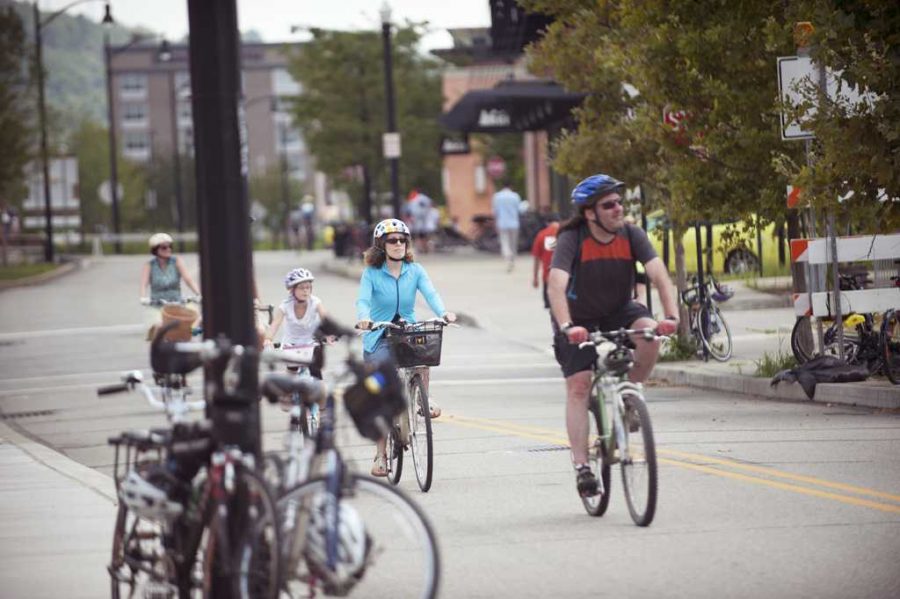I’ve had endless conversations with my cyclist friends about the stress of biking through Oakland’s crowded intersections. It’s understandable, considering the reckless nature of the city drivers who rush to and from work.
When I decided not to bring a bike to campus this year, I cited these exchanges as my reason against doing so. If my friends, who were much more experienced bikers than me, felt uncomfortable navigating the main streets of our campus, then how would I fare?
But this fear didn’t fully hit home until last Friday. Susan Hicks, the assistant director for academic affairs at Pitt’s Center for Russian and East European Studies, was hit by a car and killed while biking on Forbes Avenue near Bellefield.
To prevent future accidents, the city must work to promote greater security for our bikers, starting with a bike lane on Forbes and Fifth Avenues. More biking on our campus and across our city should be a cause for celebration, not fear.
Later that week, at the vigil held last Saturday in Hicks’ honor, grief was pervasive, but with it was also a deep sense of rage over this preventable death. Of the more than 200 people who attended, several mourners held signs that read “Not One More,” or T-shirts with the slogan “It Could’ve Been Me.”
With a 16 percent increase from 2010 to 2012 in national cyclist fatalities, according to the Governors Highway Safety Association, action to protect all of those on the road has become not only beneficial, but essential. We need to add additional bike lanes in Oakland to change how we drive with cyclists.
The biking community has risen up and demanded that the city of Pittsburgh take greater steps to ensure the safety of its cyclists, with a circulating petition that already has 2,500 signatures. BikePGH, a non-profit that promotes safe biking in the city, will take these signatures to Mayor Bill Peduto and urge him to take action to make Fifth and Forbes safer for cyclists.
While Peduto’s administration has already committed to constructing more bike lanes in Oakland, the city can’t do it alone. In order to get bike lanes in Oakland as quickly as possible, all stakeholders — the University, Port Authority, PennDOT and the city — need to work together. PennDOT actually owns Forbes avenue, while the city owns Fifth.
As Eric Boerer, Bike PGH’s advocacy director, told The Pitt News this past Friday, all parties need to be effectively communicating in order to get bike lanes up soon, and efficiently.
Yet, “There are so many moving parts,” Boerer said. “Nobody is really talking to each other.”
We need the people who operate our roads to start communicating as soon as possible, because cycling continues to increase. According to reports from The League of American Bicyclists, we have experienced an average 46 percent increase in bicycle commuters between 2005 to 2013 nationwide, for instance. With this increase comes a need for safety.
This trend is especially present in Pittsburgh, as commuting by bicycle has increased by 389 percent since 2000.
The number of bikers will only continue to rise as a result of some of the city’s recent bicycle friendly programs. Take the Pittsburgh Bike Share’s Healthy Ride System, for instance. The program started this summer, and provides a public bike sharing system that allows a rider to pick up a bike at one location and return it at any of its other 50 stations across the city. So far, the system has been successful, with over 10,000 rides in its first month, last June, according to Pittsburgh Bike Share’s website.
Policies that encourage an increase in bikers requires bike lanes to address the resulting safety challenges. Making the lanes a reality, however, requires constant communication and planning between all agents involved in their construction.
These efforts are not just for the sake of bikers, but for the sake of all Pittsburgh residents. In fact, many may not even not realize that an increase in biking has a positive, direct effect on the community as well.
For example, an increase in biking leads to less cars on the road. If we add bike lanes to Forbes and Fifth Avenues, more cyclists would feel comfortable commuting to work, inevitably leading to less traffic. This benefits drivers, not only in saving time they would otherwise spend on the road, but also in the decrease in the demand for gas that accompanies spending less time in traffic.
Those in wheelchairs and emergency vehicles can use bike lanes as well, allowing them both to avoid traffic congestions.
Every time I pass the “ghost bike” commemorating Hicks’ life, it reminds me that our streets need to be safer for cyclists. Even if they wear their helmets, like Hicks did, and learn the necessary hand signals, without a bike lane, bikers are forced to commute while carrying an uneasy awareness of their own lack of safety.
Alyssa primarily writes on social justice and political issues for The Pitt News.
Write to her at [email protected]


